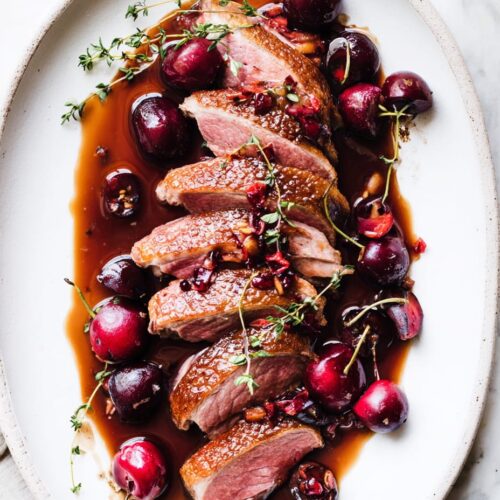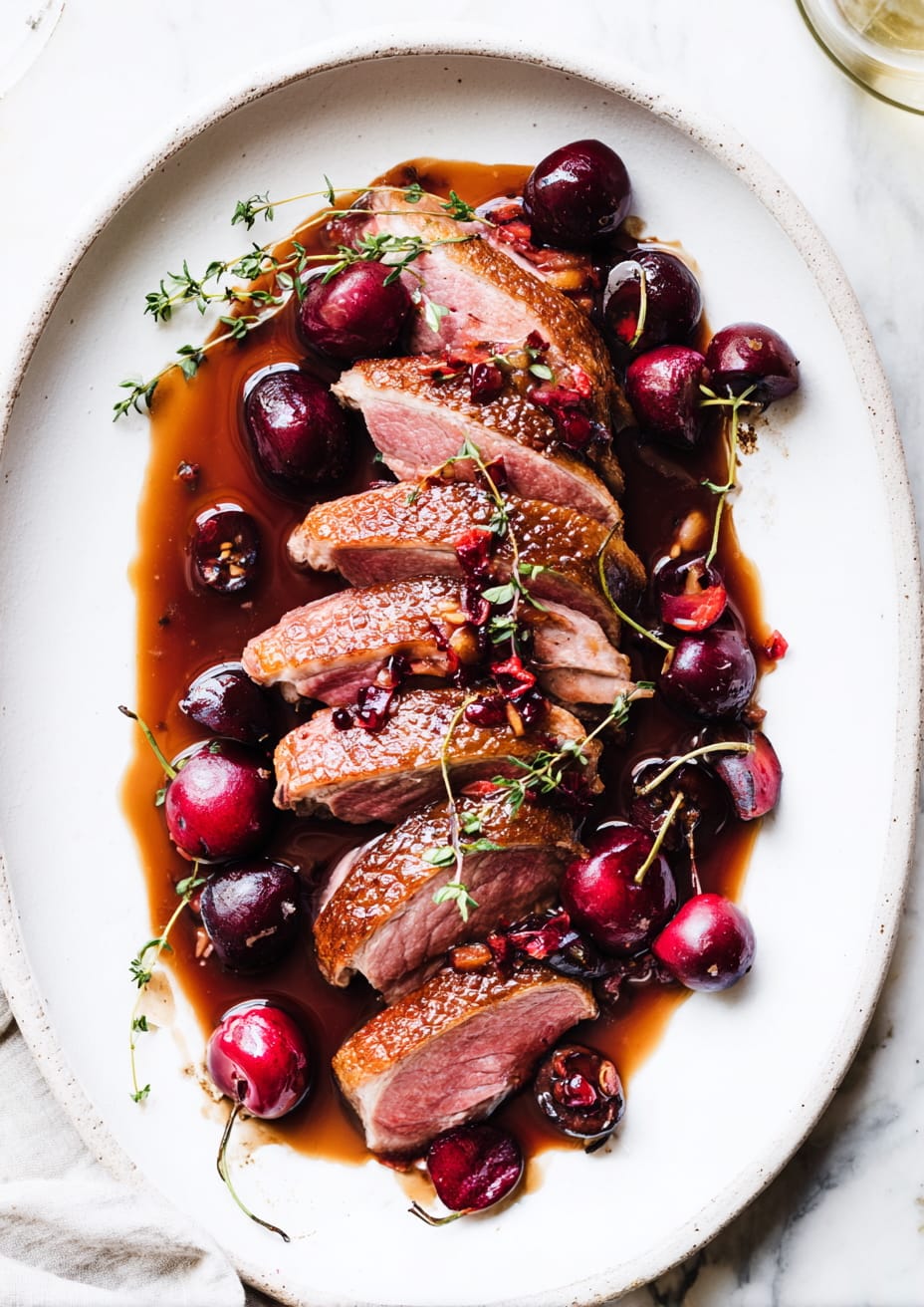Cooking duck at home often feels intimidating, but once you’ve done it a few times, it becomes one of the most rewarding proteins for a dinner table. Duck breast cooks quickly, delivers rich flavour, and always feels special without needing complicated techniques. The trick is in the sear: crisp golden skin that contrasts with tender meat beneath. Paired with a glossy red wine and cherry sauce, it’s a dish that feels elegant but doesn’t require hours of labour.
I like making duck in autumn because its natural richness pairs perfectly with fruit and wine-based sauces. The cherries bring tart sweetness that cuts through the fat, while the wine deepens everything with warmth and complexity. It’s a recipe that comes together in under an hour yet tastes like it belongs at a restaurant. I often serve it with pumpkin sides, the sweetness of pumpkin balances beautifully against the savoury duck and fruity sauce.
Ingredients you’ll need
- 4 duck breasts, about 200 g each
- 1 teaspoon sea salt
- ½ teaspoon black pepper
- 150 ml red wine (Pinot Noir works well)
- 200 g fresh or frozen cherries, pitted
- 2 tablespoons balsamic vinegar
- 1 tablespoon honey
- 1 teaspoon cornflour mixed with 2 teaspoons water
- 1 sprig fresh thyme
- 1 tablespoon unsalted butter
Method: step by step
I begin by patting the duck breasts dry with kitchen paper, then scoring the skin in a crisscross pattern, being careful not to cut into the meat. This helps render the fat and ensures the skin crisps properly. I season both sides with salt and pepper.
I place the duck breasts skin-side down in a cold frying pan, then set it over medium heat. Starting in a cold pan allows the fat to render slowly, giving me beautifully crisp skin without burning. I let the duck cook undisturbed for around 7–8 minutes, pouring off excess fat as needed, until the skin is golden and crisp. Then I flip and cook the flesh side for 2–3 minutes more.
For medium-rare, I like to transfer the duck breasts to a 180°C oven for 5 minutes. If you prefer medium, give it 7–8 minutes. I rest the duck on a warm plate, loosely covered with foil, while I make the sauce.
In the same pan, I add the red wine, cherries, balsamic vinegar, honey, thyme, and a little of the rendered duck fat. I let it bubble until the cherries soften and the liquid reduces by about half. I stir in the cornflour mixture to thicken slightly, then finish with a knob of butter for gloss. The sauce should coat the back of a spoon and taste balanced between tart, sweet, and savoury. To serve, I slice the duck breasts thinly and spoon the cherry sauce over the top.
Wine and beer pairings
Duck with red wine sauce practically demands Pinot Noir. Its cherry and raspberry notes echo the sauce while its light body keeps the pairing from feeling heavy. Another option is a Merlot, which offers plum richness and velvety tannins to match the duck.
For beer, I recommend a fruit lambic — a cherry lambic in particular highlights the sauce while cutting through the fat. Alternatively, a dubbel offers caramel and spice, standing up to the richness without overwhelming the fruit.
Frequently asked questions about duck breast
Do I need to score the skin?
Yes, it’s important for rendering the fat and getting a crisp finish. Just be careful not to cut into the flesh.
Can I use frozen cherries?
Definitely. Frozen cherries work just as well here since they soften in the sauce.
What if I prefer the duck well done?
You can cook it longer, but be aware that duck breast becomes tougher beyond medium. Slow-cooked duck legs might be a better option if you like well-done duck.
Can I make the sauce ahead?
Yes. Prepare the sauce up to a day in advance and reheat gently before serving with freshly cooked duck.
Tips for success
Start the duck in a cold pan for even fat rendering and golden skin. Resting the meat is crucial for keeping it juicy. Taste the sauce as it reduces — cherries can vary in sweetness, so you may want to adjust the honey or vinegar.
Storage and reheating
Leftover duck breast can be kept in the fridge for up to two days. Reheat gently in a low oven to avoid drying it out. The sauce keeps separately and can be frozen for later use.
Great side dish pairings
Duck with fruit always calls for something earthy on the side. I like it with Pumpkin and Feta Salad with Pomegranate and Mint, which adds freshness and crunch. Another excellent match is Pumpkin and Spinach Gratin with Fresh Sage, offering creamy contrast to the crisp-skinned duck.

Seared Duck Breast with Red Wine and Cherries
Ingredients
- 4 Duck breasts about 200g each
- 1 tsp Sea salt
- ½ tsp Black pepper freshly ground
- 150 ml red wine Pinot Noir works fine
- 200 g Cherries fresh or frozen, pitted
- 2 tbsp Balsamic vinegar
- 1 tbsp Honey runny
- 1 tsp Cornflour mixed with 2 tsp water
- 1 sprig Fresh thyme
- 1 tbsp Butter unsalted
Instructions
- begin by patting the duck breasts dry with kitchen paper, then scoring the skin in a crisscross pattern, being careful not to cut into the meat. This helps render the fat and ensures the skin crisps properly. Season both sides with salt and pepper.
- place the duck breasts skin-side down in a cold frying pan, then set it over medium heat. Starting in a cold pan allows the fat to render slowly, giving me beautifully crisp skin without burning. Let the duck cook undisturbed for around 7–8 minutes, pouring off excess fat as needed, until the skin is golden and crisp. Then flip and cook the flesh side for 2–3 minutes more.
- For medium-rare, I like to transfer the duck breasts to a 180°C oven for 5 minutes. If you prefer medium, give it 7–8 minutes. I rest the duck on a warm plate, loosely covered with foil, while I make the sauce.
- In the same pan, add the red wine, cherries, balsamic vinegar, honey, thyme, and a little of the rendered duck fat. Let it bubble until the cherries soften and the liquid reduces by about half. Stir in the cornflour mixture to thicken slightly, then finish with a knob of butter for gloss. The sauce should coat the back of a spoon and taste balanced between tart, sweet, and savoury.To serve, I slice the duck breasts thinly and spoon the cherry sauce over the top.

